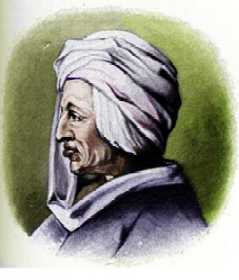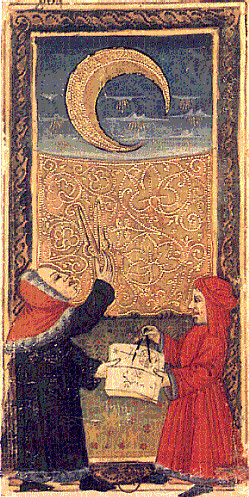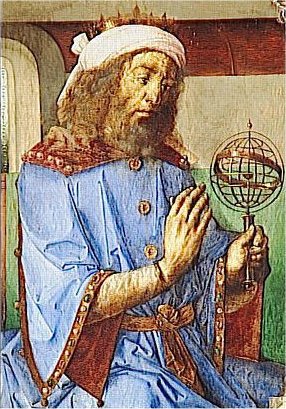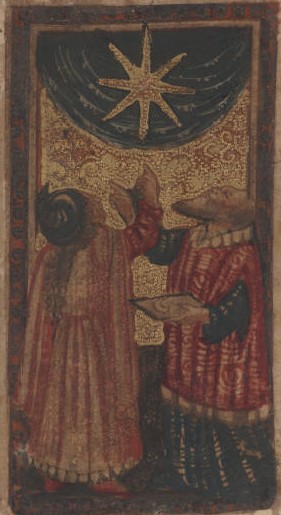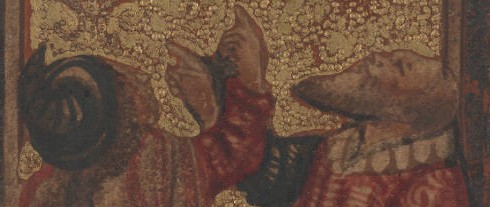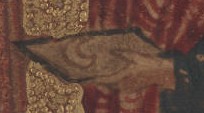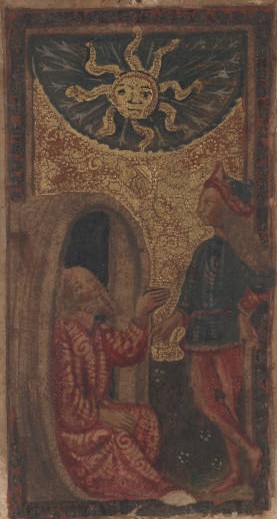Rosanne said:
Ha! That may well explain the so called Lovers card of the Charles V1 cards! The Nuptial numbers of Plato. I have often wondered why it was different- maybe the talks at Careggi Villa- so he got (Ficino) the villa then in 1462- later Lorenzo helped with Gardens I believe.
Have just read your last post and that two dimensional device may well be Marsilio Ficino's regulus. He was credited with inventing it- but that is not so as it was seen before, maybe a hundred years before.
It is like a detective story these cards and Florence and the Fleur de lis- like on the Emperor's Crown.Maybe this is why the cards look Pagan and Christian at the same time- a result of the Renaissance Platonic revival at the Academy of Florence (the Villa)?
Wonderful information Huck, Thank you
~Rosanne
PS The three Magi -I wonder about the King/Page /Knight of Cups. In other decks like Spanish Tdm's there is an Eastern look to these Courts.
Detective story is the right expression ... always a lot of persons "under suspicion" to have done something ...

We have always focussed on the trumps, not on the study of the pips. Perhaps new dimensions are opened, when these are evaluated in the total consideration. But for TdMs there is the problem that they are (likely) too young.
Actually the mind is filled with much data with this Tarot topic and it is difficult to keep things in order in the own mind.
So the methode of Trionfi.com was from beginning on, to develop the ideas from the begin and throwing "known data of later time" out of the thinking process to keep the concentration on that, what really was there in a given moment - and to proceed very slowly in the considered time.
Careggi ...
... not so impressive at first view.
But a nice garden ...
Wikipedia tell us:
"Like most villas of Florentine families, the villa remained a working farm that helped render the family self-sufficient. Cosimo's architect there, as elsewhere, was Michelozzo, who remodelled the fortified villa which had something of the character of a castello. "
It was "fortified", so much one has to add to its appearance.
"Its famous garden is walled about, like a medieval garden, overlooked by the upper-storey loggias, with which Michelozzo cautiously opened up the villa's structure. Michelozzo's Villa Medici in Fiesole has a more outward-looking, Renaissance character.
The property was purchased in 1417. At the death of Giovanni di Bicci, Cosimo il Vecchio set about remodelling the beloved villa around its loggia-enclosed central courtyard. His nephew Lorenzo extended the terraced gardens and the shaded boschi.
Marsilio Ficino, who died at the villa in 1499, was a central member of the academy. Lorenzo de' Medici died at the villa in 1492, after which it was ignored for a time .... "
... the Medici-possessions were plundered in 1494 and the Medici were expelled, at least one branch of the family.
In Florence the Rucellai garden had also some importance, likely following in their function the earlier Medici dominance. The host was Bernardo Rucellai:
"And our Bernardo, who stands out more prominently than the rest on this purple back-ground, had added all sorts of distinction to the family name: he had married the sister of Lorenzo de' Medici, and had had the most splendid wedding in the memory of Florentine upholstery; and for these and other virtues he had been sent on embassies to France and Venice, and had been chosen Gonfaloniere; he had not only built himself a fine palace, but had finished putting the black and white marble facade to the church of Santa Maria Novella ; he had planted a garden with rare trees, and had made it classic ground by receiving within it the meetings of the Platonic Academy, orphaned by the death of Lorenzo ; he had written an excellent, learned book, of a new topographical sort, about ancient Rome; he had collected antiquities ; he had a pure Latinity."
http://books.google.com/books?id=Kl...lai+garden&as_brr=1&ei=5SyGR-_NN5D26wKQ6MGVBg
It's said, that Cosimo di Medici died in Careggi (1464), that Lorenzo died here (1492) and that Ficino died here (1499).
The distance - always of importance to understand something - is about of 7 km of Florence cities. So guests needn't to stay over the night (a good distance for a ride on a horse, a pedestrians with some problems), but far enough to have some calm of the troubles of the cities.
In 1466 some adversaries tried to attack Piero on his way from Careggi to Florence, Lorenzo could warn him in time to take another way (famous scene).
For the 3 sick older Medici's in the early 60's it was troublesome to make the distance.
For Pulci in the Mugello the distance to Careggi was a little nearer than to Florence. Cosimo died there, so Ficino and the platonical academy (as far as it existed) was "for Cosimo" one could judge. Pietro spared money ... this was risky and let to rebellion. One doesn't hear too much of the platonic academy, although it is said, that Pietro was interested in serious talking. We cannot exspect too much of this scene.
The man or boy with the new energy is Lorenzo. And the strong woman in the household with two healthy legs to walk, Lucrezia Turnobuoni. And beside her there is her brother brother, who becomes partner of the Medici, a man in the background.
One should think, that the early Careggi-scene is idealized by the later successful and vital phase with Lorenzo.
Pietro protested against Lucrezia, that she moved responsibilitis too early to Lorenzo.
Pulci got in financial trouble in 1465 cause of his brother Luca and had to fled the city. He was rather desperated about this and wrote letters about this trouble to Lorenzo.
The idea is somehow given, that the difficulties of Luigi Pulci have a very concrete relation to the new financial course of Pietro and not only to the financial difficulties of Luca.
Pietro tried to get money back, that was credited before. A lot of people had financial trouble and that helped some persons with rebellious spirit to try to change something. A war resulted, a battle was fought. Colleoni was engaged, Ercole d'Este seriously wounded at the opponent's side, on Florentine side Montefeltro earned some of the money, by which he become rather rich. Perhaps not really necessary expenses.
It's difficult to say, what was going on in Careggi. Pietro used it ... he was on the way of Careggi, when the attack on him was projected.
Well, something in matters of playing cards had happened. Forom our site:
http://trionfi.com/0/p/09/
1466: In an older reference it is noted, that the poet Luigi Pulci (1432 - 1484) wrote a letter to the young Lorenzo de Medici, in which the term "Minchiate" appears. Considerable research was done by Franco Pratesi to detect the original letter, however, the information was not traceable.
However, according Pratesi, "the letter was first published - as most of Pulci's letters - only in 1868 in a limited edition for a wedding by Bongi, who again published it in 1882 in a more complete and common book. The following edition has been in Morgante e Lettere by De Robertis, in 1962, reprinted with some slight revisions (which do not concern either the letter or the notes to it) in 1984. The mentioned letter appears unchanged through the different editions." The letter was written at 23rd August 1466. Franco Pratesi describes: "Pulci is passing the summer in a land possession and writes to Lorenzo that he is craving to see him again to the point that, had he only a horse, he would come there to play together at different games and win by large. The exact text of the relevant sentence is, 'Pure, se havessi cavallo, ho s� gran voglia di rivederti ch'io verrei cost� per isvisarti alle minchiate, a passadieci, a sbaraglino, come tu sai ch'io ti concio.'" The different games mentioned are Minchiate, Passadieci (different games with dice) and Sbaraglino (boardgame out of the backgammon family). Pratesi comments: "The only difficult term, from a language point of view, is the verb isvisare for svisare, meaning not only to win a match but to disfigure the face with punches. The sense is obviously metaphoric, stressing the higher level of Pulci as a player. The three mentioned games are minchiate, which needs no comment for the moment; passadieci, a common name for different games played with dice only (with the aim to or not to surpass ten), with dice and board (with the peculiarity of counting doubles twice), and perhaps even with cards; sbaraglino, a favourite boardgame of the backgammon family whose popularity lasted for several centuries. In the same letter some common programs to compose verses are also reminded. Evidently, Pulci exploited his supremacy in poetry and in games over the young Lorenzo (17 years old at the time, compared to 34 for Pulci) to continue his friendly relationships with the Medici family."
(from Franco Pratesi: Florentine Cards - New Discoveries IV, written Florence, August-October 1986, published later in the Playing Card Journal).
Pulci has no horse. That might mean, that he still has financial difficulties. But a new game called "Minchiate" was there. Perhaps a "normal" Trionfi game, just renamed. We cannot exspect "40 special cards" ... it would be to big a jump. But it seems to have been some experimentation with the cards. Not 14 ... another number.
Actually there 4 decks, which might be of interest in the Florentian development:
1. a 1450 deck
2. a deck for the emperor-meeting-the-bride-scene, 1452 (perhaps this deck came from Florence)
3. a deck in 1463, somehow causing the new law
4. the Minchiate version, before Pulci's letter
Naturally there might have been more, but what shall we consider things, of which we have not a single indication.
Naturally there might have been also less decks, for instance Nr. 3 might have been identical to Nr. 4, and Nr. 2 might have been "not from Florence" - but for instancve from Ferrara, where the emperor had been before he arrived in the Florentian-Ferrarese region.
For the Charles VI deck we have some argumentation, that this shouldn't have his production date before 1461, 1463 doesn't look unlikely.



